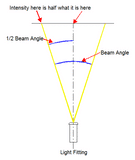Take A Quick Course On Lighting Terms To Help You Understand The Lamp Type Suitable For Your Needs.
Lumen
A lumen is a unit of measurement used to show exactly how bright a light source is. A single lumen is equivalent to one candle. A lamp that has a output of 50 lumens is just as bright as 50 candles.
The higher the amount of lumens, the brighter the light. The short abbreviation of lumens is " lm "
Color rendering index
Color rendering Index (CRI) is a way of measuring how vibrant and rich a light source makes colors appear in your eyes
In other words, it’s a measurement of the light color quality and basically a measurement of how light reflects off inanimate objects when they collide.
The index ranges from 0 to 100. A light’s CRI can only be compared to another light if they have the same color temperature, which is explained below.
Color temperature
The color temperature is the way a light appears in color to your eyes.
For light bulb terms , the main colors you will see advertised is warm white , neutral white , and cool white (pure white).
The light color is measured in kelvin temperature ( please see chart above ). The lower the kelvin temperature number , the warmer the light color. As we move up the chart , light color becomes cooler.
Our traditional light bulbs are colored like a burning fire , therefore the color temperature is low under 3000. You can select a color for your bulbs that is suitable for your needs and eyes.
Design life time
Design lifetime is the average lifespan of a lighting product when operated at nominal lamp and recommended input voltage.
A light’s lifespan will depend on its type. Incandescent lamps are the cheapest and will last approximately one year. In contrast, LEDs have a high initial cost but will not need to be changed for over 10 years.
Power factor / lumen efficiency
Power Factor/Luminous efficiency measures how efficient a specific light source is at converting electricity power to light.
It is measured in lumen output per unit power input (watt). Efficiency = lumen / wattage
Beam angle
Beam angle refers to a light bulb's measure of lighting spread and is measured in degrees.
A light’s beam angle is determined when its lux level drops to half of the intensity of the center beam (see diagram). Beam angles are commonly 30, 60 and 90 degrees and can be custom made
LED chips require a lens to create the beam angle as LED chips are directional. The lens used creates the beam angles for more efficient lighting.
Lux
Lux is the measurement of light intensity falling and reflecting on a surface. This measurement determines the brightness of a specific light in a space.
Lux meters are available to determine light brightness levels and evaluate the energy efficiency of lighting designs and lighting sources
• One lumen per square meter = One lux
Dimming capabilities
Dimmable light bulbs can be adjusted to the right intensity and deliver different amounts of light for different occasions and times.
The range of light levels a bulb can produce will be affected by its dimmability. Not all LED light bulbs are dimmable but this will be clearly stated on the packaging.
Watts
A watt is a unit of electrical power. We measure electrical usage in watts and pay for our electricity according to the number of watts we use. Typically, a standard halogen incandescent bulb operates at 50 watts. In contrast, LEDs can be just as bright while using about one tenth of the watts. The technology trend will see the new generation of LEDs using one twentieth of the watts.








